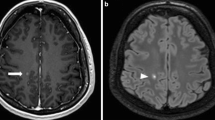Abstract
Background
Epidemiological, pathological and radiological studies suggest that inflammatory demyelination in MS is an age-dependent process, and that the formation of focal inflammatory demyelinating lesions decreases with age. Gadolinium-enhancing lesions are a biomarker of inflammatory disease activity in MS, but little is known about the relation of age and gadolinium enhancement on cranial MRI scans in people with MS. In this study, we investigated the association of age and other risk factors with gadolinium enhancement on cranial MRI in a retrospective cross-sectional clinical MS cohort.
Methods
In a cohort including 1543 people with CIS and MS, we investigated the association of the risk factors age, sex, disease course, immunomodulatory drug (IMD) treatment, and disability with gadolinium enhancement on cranial MRI scans using a binary logistic regression model.
Results
Age was the most important factor associated with gadolinium enhancement, with the odds of gadolinium enhancement decreasing with advancing age. Participants with CIS had lower odds of gadolinium enhancement (odds ratio of 0.42, 95% confidence interval of 0.24–0.72 compared to RRMS). Sex, disease course and IMD treatment were not significantly associated with gadolinium enhancement in our cohort.
Conclusions
Our investigation shows that gadolinium enhancement is strongly associated with age. Since gadolinium enhancement is a marker of inflammatory disease activity, our findings suggest that inflammatory disease activity declines with age, and that IMD treatment may be more beneficial in younger and less useful in older people with MS.


Similar content being viewed by others
Data availability
The longitudinal study we used for these analyses began in 2001, before it was common to share de-identified data. Therefore, unfortunately, we do not have patient consent or approval from our institutional research ethics board to share individual patient level data. Processes are underway to change this for future data collected.
References
Reich DS, Lucchinetti CF, Calabresi PA (2018) Multiple sclerosis. N Engl J Med 378:169–180. https://doi.org/10.1056/NEJMra1401483
Thompson AJ, Baranzini SE, Geurts J et al (2018) Multiple sclerosis. Lancet Lond Engl 391:1622–1636. https://doi.org/10.1016/S0140-6736(18)30481-1
Li DKB, Li MJ, Traboulsee A et al (2006) The use of MRI as an outcome measure in clinical trials. Adv Neurol 98:203–226
Tremlett H, Zhao Y, Joseph J et al (2008) Relapses in multiple sclerosis are age- and time-dependent. J Neurol Neurosurg Psychiatry 79:1368–1374. https://doi.org/10.1136/jnnp.2008.145805
Tortorella C, Bellacosa A, Paolicelli D et al (2005) Age-related gadolinium-enhancement of MRI brain lesions in multiple sclerosis. J Neurol Sci 239:95–99. https://doi.org/10.1016/j.jns.2005.08.006
Frischer JM, Weigand SD, Guo Y et al (2015) Clinical and pathological insights into the dynamic nature of the white matter multiple sclerosis plaque. Ann Neurol 78:710–721. https://doi.org/10.1002/ana.24497
Kurtzke JF (1983) Rating neurologic impairment in multiple sclerosis: an expanded disability status scale (EDSS). Neurology 33:1444–1452
Development Core Team R (2019) R: A language and environment for statistical computing. R Foundation for Statistical Computing, Vienna
Schwehr NA, Kuntz KM, Butler M et al (2019) Age-related decreases in relapses among adults with relapsing-onset multiple sclerosis. Mult Scler Houndmills Basingstoke Engl 1:1. https://doi.org/10.1177/1352458519866613[epub ahead of print]
Polman CH, Reingold SC, Banwell B et al (2011) Diagnostic criteria for multiple sclerosis: 2010 revisions to the McDonald criteria. Ann Neurol 69:292–302. https://doi.org/10.1002/ana.22366
Chung KK, Altmann D, Barkhof F et al (2019) A thirty year clinical and MRI observational study of multiple sclerosis and clinically isolated syndromes. Ann Neurol 1:1. https://doi.org/10.1002/ana.25637[epub ahead of print]
Optic Neuritis Study Group (2008) Multiple sclerosis risk after optic neuritis: final optic neuritis treatment trial follow-up. Arch Neurol 65:727–732. https://doi.org/10.1001/archneur.65.6.727
Ingle GT, Sastre-Garriga J, Miller DH, Thompson AJ (2005) Is inflammation important in early PPMS? A longitudinal MRI study. J Neurol Neurosurg Psychiatry 76:1255–1258. https://doi.org/10.1136/jnnp.2004.036590
Khaleeli Z, Ciccarelli O, Mizskiel K et al (2010) Lesion enhancement diminishes with time in primary progressive multiple sclerosis. Mult Scler Houndmills Basingstoke Engl 16:317–324. https://doi.org/10.1177/1352458509358090
Wolinsky JS, Narayana PA, O’Connor P et al (2007) Glatiramer acetate in primary progressive multiple sclerosis: results of a multinational, multicenter, double-blind, placebo-controlled trial. Ann Neurol 61:14–24. https://doi.org/10.1002/ana.21079
Lublin F, Miller DH, Freedman MS et al (2016) Oral fingolimod in primary progressive multiple sclerosis (INFORMS): a phase 3, randomised, double-blind, placebo-controlled trial. Lancet Lond Engl 387:1075–1084. https://doi.org/10.1016/S0140-6736(15)01314-8
Montalban X, Hauser SL, Kappos L et al (2017) Ocrelizumab versus placebo in primary progressive multiple sclerosis. N Engl J Med 376:209–220. https://doi.org/10.1056/NEJMoa1606468
Weideman AM, Tapia-Maltos MA, Johnson K et al (2017) Meta-analysis of the age-dependent efficacy of multiple sclerosis treatments. Front Neurol 8:577. https://doi.org/10.3389/fneur.2017.00577
Vaughn CB, Jakimovski D, Kavak KS et al (2019) Epidemiology and treatment of multiple sclerosis in elderly populations. Nat Rev Neurol 15:329–342. https://doi.org/10.1038/s41582-019-0183-3
Funding
None.
Author information
Authors and Affiliations
Corresponding author
Ethics declarations
Conflicts of interest
Dr. Koch reports personal fees and non-financial support from Biogen Idec, personal fees and non-financial support from EMD Serono, personal fees and non-financial support from Novartis, personal fees and non-financial support from Roche, and personal fees and non-financial support from Sanofi Genzyme. Dr. Mostert has nothing to disclose. Ms. Greenfield has nothing to disclose. Dr. Liu reports personal fees from EMD Serono, personal fees from Novartis, and personal fees from Sanofi Genzyme. Prof. Metz has nothing to disclose.
Ethics approval
All participants included in these analyses have given their written informed consent to participate in an ongoing longitudinal study of outcomes and predictors of MS, or a waiver of consent was provided by the University of Calgary’s Conjoint Health Research Ethics Board (CHREB). Ethical approval was granted by CHREB.
Rights and permissions
About this article
Cite this article
Koch, M.W., Mostert, J., Greenfield, J. et al. Gadolinium enhancement on cranial MRI in multiple sclerosis is age dependent. J Neurol 267, 2619–2624 (2020). https://doi.org/10.1007/s00415-020-09895-0
Received:
Revised:
Accepted:
Published:
Issue Date:
DOI: https://doi.org/10.1007/s00415-020-09895-0




